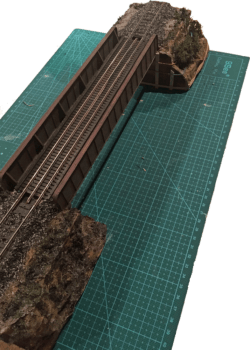

Lately, I have participated in a Facebook forum on Budget Model Railway. I like the various tricks for building models using cheap materials, without worrying too much about being prototypical (close to the original model). The group is in English, and participation seems dominated by people from the USA. Not a demographic I usually interact with.
While the hobby is the same, and the dominant scale in the US is also H0 (1:87), there are some interesting differences – some caused by the differences in actual railways, some by different markets. Here are some observations (in no particular order) based on my interactions and some reading of US railroading magazines.
- Freight is the rule, passenger train the exception – this is pretty much a mirror of the situation in the USA.
- There does not seem to be a formal system to reference time (like the NEM 800 epochs), and as I’m unfamiliar with US rolling stock, it is difficult for me to clearly identify which time-frame people model. One common one seem to be the period between the 80s and the turn of the century. Which is interesting as European modelling the US seem to prefer the early diesel period.
- Diesel locomotives are the most common, followed by steam for historical modelling. Electric is rare. Compared to Europe, switching locomotives are very heavy and long. Generally, US locomotives look massive.
- Small, two axle wagons seem to be non-existent in the US. So are small turntable on industrial spurs. Generally, US loading gauges are higher than the UIC one, so things like double stack container trains are a thing.
- As most of the operators are private, creating an imaginary company with its own name, livery and logos makes sense. Before the liberalisation of the European rail network, in Europe this would amount to imagine a whole country (an idea I’m playing with – I’m thinking of modelling the region of Besźel).
- In H0 scale, two rail systems are the rule. Märklin in an exotic brand. Lionel uses a three-rail system (at 0 scale).
- There are many different couplers, but no standard coupler attachment mechanism (like NEM 362). The standard NEM 360 hook and loop coupler used by Märklin and others is not used. Short coupling seems to be less of theme, maybe because of the predominance of freight. Locomotives capable or remote decoupling (like the Märklin Telex system) seem to be unknown.
- Plastic wheel-sets are a thing. This is something I never encountered in European models, even the cheap Lima stuff.
- Imperial measures are hard. Railroad modelling does not generally involve complex mathematics, the two most common operations are computing slope (expressed in percent) and computing scaling (in H0, the ration is 1:87), but these typically span multiple imperial units, so things get a bit complicated: while 1 cm in H0 model is 87 cm in reality, one inch 7.25 feet (1 ÷ 87 × 12). Similarly a 4% slope means an elevation of 4 cm over a distance of 1m, but 0.48 inches (4 ÷ 100 × 12) over a foot. It seems I’m not the only one confused by this, as there were a few people asking about these conversions.
One thought on “Compared Model Railway”